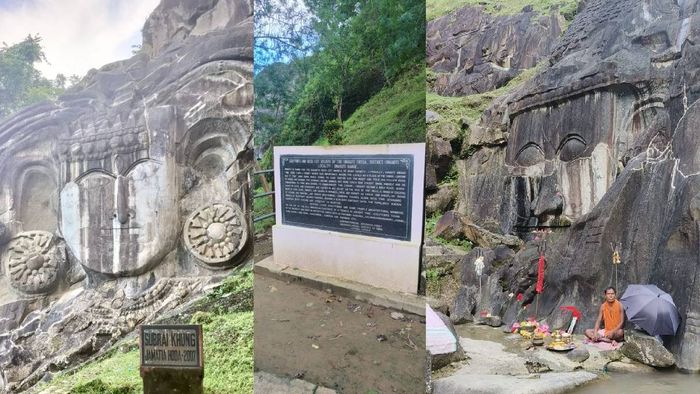Tripura’s Unakoti: Brave the travel as a rock-solid cultural adventure awaits
Tripura's Unakoti, often called the Angkor Wat of the North East, is a journey through time and culture. Despite challenging travel conditions, the site offers an unforgettable experience with its ancient rock carvings and sculptures.

- Jul 01, 2024,
- Updated Jul 01, 2024, 6:55 PM IST
The Angkor Wat of the North East - the renowned Unakoti in Tripura echoes the adage that "the harder the climb, the sweeter the view." Journeying to this serene landscape is akin to embarking on a thrilling yet captivating journey through nature, and what awaits is an unforgettable experience.
Nestled in the midst of lush green forests about 170 kms from Tripura’s capital city Agartala and 148 kms from Silchar, Unakoti may not seem that long of a distance but what if one was to traverse through not just ups and downs but extreme dilapidated road conditions, particularly during the monsoon season, unveiling a breathtaking panorama with every turn.
Such is the rollercoaster ride through nature that eventually leads one to the ancient Shaivite place that is home to numerous rock carvings and sculptures of gods and goddesses, each holding a mythological tale dating back to ancient times. However, the journey to the site and the site itself narrate a tale of long-term neglect, particularly evident during the monsoon season when showers unveil the ravages of nature.
Adorned with rock-carved figures and stone images, the site of Unakoti is a sight to behold. Added to the tentative list of UNESCO World Heritage sites in 2022, Unakoti, which literally means "one less than one crore" or "koti" in Hindi, derives its name and identity from folklores that have endured through generations.
Legend has it...the place is home to an astounding ninety-nine lakh ninety-nine thousand nine hundred and ninety-nine idols. According to folklore, Lord Shiva, accompanied by 99,99,999 deities, spent a night at the Unakoti village and cursed his followers to stone when they failed to awaken before sunrise to continue the journey towards Kashi. Today, these stone sculptures stand as a testament to this ancient myth.
Another local folklore tells the tale of Kallu Gurjar, a devout follower of Goddess Parvati, who yearned to accompany her and Lord Shiva to Mount Kailash. Upon Parvati's insistence, Lord Shiva agreed, challenging Kallu to craft one crore idols of him overnight. Immersed in his task, Kallu worked tirelessly, but at dawn, one idol remained unfinished, falling short by one crore (or 'Unakoti'). Displeased, Lord Shiva left Kallu and his idols at Unakoti, continuing his journey alone.
Embarking from Agartala, the journey begins early morning with a scenic train ride from Agartala Railway Station to Dharmanagar Railway Station. A short, 40-45 minute car ride follows, promising an adventurous trip full of twists and turns, amidst which travelers are treated to captivating views of the surrounding landscapes, glimpses of nature, and quaint settlements dotting the route. The real challenge, however, lies in the overall expense taken to reach the destination.
As visitors set forth on the long journey spanning approximately 5 hours from Dharmanagar to the enchanting site of Unakoti, they encounter dilapidated road conditions that whisper tales of neglect towards this heritage site. Nevertheless, one is bound to crescendo with excitement on nearing the destination.
On reaching Unakoti after a tiring ride, curious eyes make way towards the rock carvings through winding paths coming across brief, serene waterfalls which cascade gently amidst the verdant surroundings, creating a picturesque contrast. While it is humanly impossible to lay eyes on the many idols concealed in the nooks and corners of the site, of the 99,999,999 idols known to have existed, many have either been washed away, damaged, or hidden beneath nature’s desolation.
During the monsoon, however, the journey undergoes a dramatic transformation into a challenging ordeal. The once serene ride turns into a tumultuous adventure, navigating wet and muddy roads with no shelters for respite. The rainfall not only blurs the landscape but also adds an element of difficulty, turning what was once excitement into a task.
The roads leading to the destination have not been properly developed, retaining a rural outlook. Muddy roads obstruct what would otherwise be a smooth ride, making it difficult for vehicles to travel easily. During the monsoon season, continuous rainfall inundates the roads, occasionally causing heavy vehicles to get stuck. This results in long queues of traffic, with passengers anxiously seeking a way out amidst the surroundings of muddy water and rain-affected nature.
However, despite the daunting task of reaching the destination, every person should, at least once, immerse themselves in the majesty that the place holds. After traversing a long path and then a trail of steps to enter the haven of rock carvings, visitors are greeted with the figures of the heads of Lord Shiva and Lord Ganesha in the central part of the site. Known as Unakotiswara Kal Bhairava, the figure of Lord Shiva’s head is approximately 30 feet high, flanked by two other figures—Goddess Durga on a lion and another female figure—on either side.
Unakoti is not just a site; it is a journey through time and culture, where every corner reveals a new story etched entirely in stone. One might be captivated by the artistic craftsmanship or simply drawn to the tranquility of its natural setting, but certainly, Unakoti promises an experience that leaves a lasting impression on the soul.